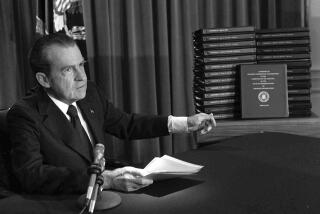‘Reversibility’ Allows Cheney to Hedge Bets : Defense: Cutbacks center on areas that would allow for a quick rearming should East Bloc reforms fail and tensions escalate.
- Share via
WASHINGTON — In devising a 1991 defense budget that responds to the remarkable upheaval under way in the Soviet Bloc, Defense Secretary Dick Cheney and his senior advisers have coined a new watchword: reversibility.
In planning massive cuts, Cheney is choosing measures that would allow a quick reversal of declining U.S. firepower if Mikhail S. Gorbachev’s reform program suddenly collapses and the Soviet Union reverts to the politics of military power, defense officials say.
This method of hedging bets, reflected in the 1991 budget plan that Cheney has presented to the White House, reflects the Pentagon’s strategy of coping with the demand for big savings amid continuing concern about how far East-West peace will go.
A senior officer active in planning for the future explained the concept by saying: “You’ve got to use the same principles going down as you would going up, so you don’t foreclose the possibility (of renewed conflict.) You cannot replace the infrastructure (such as military bases and production lines) overnight. So we proposed not to give up some things that we would not be able to do without if we had to rebuild.”
For example, officials said, once a foreign base is closed, it might never be regained. Consequently, the Army foresees no such closures in the next two years. Moreover, research and development not only will avoid cuts, but will be expanded.
Last April, Cheney made headlines and staked his position as one of the Bush Administration’s most hawkish voices on Soviet issues when he predicted that Gorbachev would fail in his reform efforts and be replaced by someone less willing to deal constructively with Washington.
Officials said that Cheney’s skepticism has had a significant impact on which Pentagon programs will thrive next year and which will endure precipitous change. At roughly $295 billion, Cheney’s revised 1991 budget is $16 billion below earlier Pentagon plans.
In an Oval Office interview with wire service reporters Monday, President Bush reflected Cheney’s caution, saying that he would not make “any naive, unilateral” cuts in the military budget. Instead, he said, the United States will “move forward on a sensible program of evaluation and a sensible program of arms reduction.”
He added: “If people are looking for us to make massive cuts now, I say, ‘look, help us get the kind of agreements’ ” needed for superpower security.
The Defense Department’s decisions about cutting personnel in 1991 also reflect the desire to avoid dismantling the services in a way that is particularly hard to reverse. Although the three services may have 100,000 fewer personnel by the end of 1991, officials said it will be at least two years before entire units are disbanded.
The Army faces the deepest cuts in manpower, but even so, Cheney has not proposed the closure of any U.S. Army bases as part of his 1991 budget submission, Administration officials said.
Cheney also accepted Army recommendations designed to allow it to regain its combat power quickly. For instance, under Cheney’s plan the Army would continue research and development on such futuristic gadgetry as the turretless tank, even though there are no plans for production.
At the same time, Cheney largely accepted Army proposals to continue programs to develop officers’ command and fighting skills, and to protect large field and computer exercises from further cutbacks.
“You don’t want to change so unconditionally that you can’t reverse whatever movement you decide upon,” said one senior officer familiar with Cheney’s budget and strategy meetings.
“Not even the best and the brightest can look into their crystal balls and tell what the Soviet Union and Eastern Europe are going to look like,” he added. “All they’re saying is we need to do things to adjust to that. And we need to do it intelligently, so that if there is a slowdown, a leveling out or an abrupt stoppage, we’re not in a position where we’re left naked.”
The Navy, too, succeeded in forestalling any retirement in 1991 of an aircraft carrier, although as many as two could face early retirement by 1994 if the Pentagon’s worst-case budget pressures come true. The Navy argued that it would take too long to take an aircraft carrier out of mothballs.
Instead, Cheney adopted the Navy’s recommendation to cut two battleships after the service argued that such ships could be reactivated in six months if world events dictate a change of course for American military policy.
Similarly, Cheney recommended growth for military research and development, which next year would rise to $38 billion from this year’s level of $36.8 billion.
In an interview last month with The Times, Cheney warned that his own views on Gorbachev’s prospects would dictate a continued strong investment in military research and development.
“If we get a fundamental shift in Soviet policy, we have to make sure that we have protected our (research and development) base,” Cheney said. Calling U.S. technological advantages over the Soviet Union “absolutely crucial,” Cheney added: “You’ve got to structure your investment strategy accordingly.”
More to Read
Sign up for Essential California
The most important California stories and recommendations in your inbox every morning.
You may occasionally receive promotional content from the Los Angeles Times.














